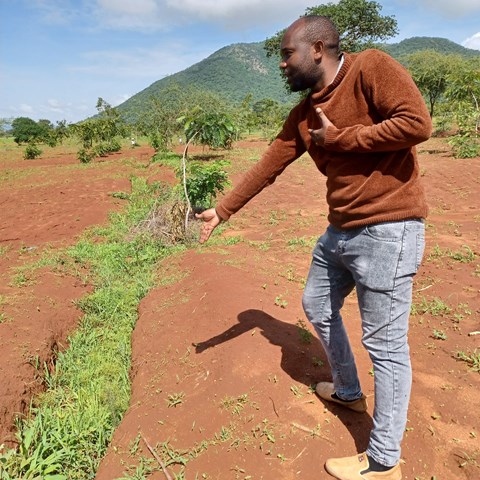Research shows that too little understanding of and attention to local contexts in project design and implementation are key reasons behind this fact.
Furthermore, the degree of risks that projects involve for local communities are rarely fully considered. Many projects have been shown to involve much larger risks for local farmers than for the donor/project proponent, the government or other actors with much more resources and influence.
Click on the arrow below each question to read about more concrete examples of problems that can happen.
 Questions to ask
Questions to ask
Have you clearly shown that expected benefits from the project are based on needs actually expressed by the local communities, and taking into consideration that different groups within the community may have different needs?
Examples
For example, if a group of hunter-gatherers will have the forest in which they hunt protected from grazing and cutting of trees – have you discussed with the herders how their need of grazing land or those using trees for building or firewood will be affected?”
Do you provide a description about how socio-economic benefits are assessed in relation to risks or negative consequences?
Examples
For example, is the trade-off between earning income by cutting trees and selling them vs. leaving them to grow and absorb carbon discussed? How is the frequent need for emergency cash among people with little or no economic buffer dealt with if they, for example, are restricted from collecting wood for fast cash incomes?
How do you ensure that the influx of money to communities from the project that you are working with does not cause or increase inequalities or cause debt?
Examples
For example, if project money is used to set up a school fee fund or hospital fund – how will equal access to the money be ensured? If a project contributes to building a new building such as a school block or clinic, each household may be asked to contribute by the community leadership to cover parts of the construction costs. It is common in rural areas in many countries that households are expected to contribute to common buildings, and poor households are usually expected to contribute the same amount as rich and may become indebted.
For project evaluation, is there a description of how people will be selected for evaluation to ensure a representative sample? Is there a strategy for obtaining the views of the most marginalized groups too? Is there a description of how it will be verified that positive changes in local lives are actually due to the project?
Examples
For example, does the project standard specify a minimum sample size of local people from different social status groups (people with different access to social, political and natural resources, such as social networks, decision making, information and land) when evaluating the project?
Do you as a project proponent tackle different risks by thorough and context based risk analysis, not solely referring to following standards, laws or guidelines, without explaining how those guidelines or laws will reduce risk in that particular context?
Examples
For example, many countries have relaxed laws about impacts on local populations. Guards guarding plantations may be allowed to shoot at local people who venture into a tree plantation. Simply referring to following local laws or regulations may not ensure that people are treated in ways that buyers of offsets would expect.
If the project aims at reducing illegal activities, is it described how you will support vulnerable people who engage in illegal activities for their livelihoods?
Examples
For example, projects focusing on protecting carbon stocks in trees may evict people using dry or living wood for charcoal making even in cases when they really need cash, for example for medical emergencies.
Has a risk analysis been made and is it thorough, considering different parts of the community, risks of unforeseen events and risks that the project fails in different ways?
Examples
For example, market-related risk could have severe negative impacts such as fluctuating commodity prices or unreliable global demand. Most communities do not have different carbon projects to choose between – they cannot bargain for better price for their carbon storage. What happens if insects, forest fires or other unforeseen events destroy the trees – are all risks taken by the communities who will not get paid in these cases?
Are risks for sustainable carbon sequestration and socio-economic risks given equal attention in the risk analysis?
Examples
Often carbon-related risks are given a lot of space while socio-economic issues are not analysed in as much detail, even if they are very complex and risks are high.
Have you developed mitigation measures in relation to risks in a way that they reflect local communities´ perspectives? Are your mitigation measures sufficiently detailed to actually mitigate significant risks?
Examples
For example, if you as a project proponent suggest that communication with a local leader will reduce socio-economic risks for all farmers and herders participating in a project you are working with, this does not describe how the local leader will be able to handle the risks and it doesn’t take into account power relations between the leader and other community members
Does the project budget include expenses for important social issues?
Examples
For example, does the budget include resources for the identification of vulnerable/marginal groups, carrying out participation processes, dealing with land conflicts and complaints?
 Warning signs
Warning signs
Benefits are linked to different conditions, indicating that persons who expect gains will risk missing out unless they find ways to claim that the conditions were indeed met.
Examples
For example conditions could be that participants need to be property owners and/or with secure land access, trees have to grow at a certain speed, or remain standing for 20 years. Conditions always present a stress and a risk of exclusion, which invites deceptive practices. They must be very carefully considered and fair to people participating.
Large cash payments to individuals are planned in order to convince them to join the programme.
Examples
If it is a useful project that is adapted to people’s ongoing livelihoods, it will often pick up through no or smaller incentives such as simple equipment or free training, and then spread organically. Large payments to certain individuals in a community are likely to cause jealousy, accusations of corruption and various other local conflicts.
Evaluations will only look at quantitative measures (such as number of trees planted or number of farmers enrolled) and not investigate impacts based on interviews with different groups in the local community about how they experience the benefits and challenges with the project.
Examples
Such figures frequently hide local concerns and especially from marginal groups who may need to be actively sought up and interviewed by staff trained for this purpose.
